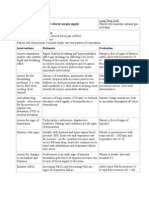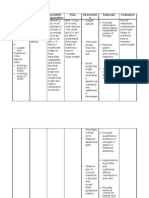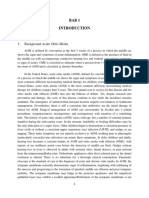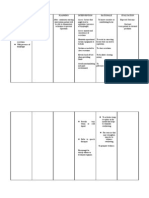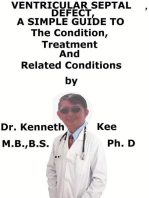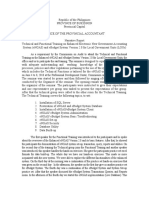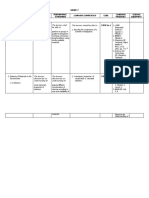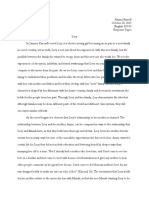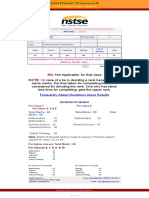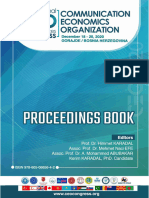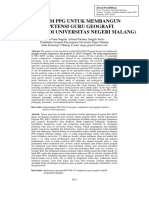Nursing Care Plan Final
Nursing Care Plan Final
Uploaded by
Erickson OcialCopyright:
Available Formats
Nursing Care Plan Final
Nursing Care Plan Final
Uploaded by
Erickson OcialOriginal Description:
Copyright
Available Formats
Share this document
Did you find this document useful?
Is this content inappropriate?
Copyright:
Available Formats
Nursing Care Plan Final
Nursing Care Plan Final
Uploaded by
Erickson OcialCopyright:
Available Formats
NURSING CARE PLAN
ASSESMENT
NURSING
GOAL OF CARE
S: Ma init katawan
DIAGNOSIS
Hyperthermia related
After 10 hours of
ko As verbalized by
to the infectious
comprehensive nursing
process
intervention, the patient
client
O:
temperature will lower
-Skin warm to touch
down to normal levels:
with a temperature of
T: 36.5C 37.5C
38.0C
-Weakness observed
-Dry mucous
membranes
-Flushed Skin
-Pallor in palms
-WBC 3.18
-Hgb 10.9g/dL
-Hct 30.8%
-RBC 3.5g/
ASSESMENT
NURSING
GOAL OF CARE
INTERVENTION
INDEPENDENT
1. Provided tepid sponge
bath.
2. Assessed fluid loss &
facilitate oral intake.
3. Promoted bed rest.
4. Provided cool
circulating air using a
fan.
5. Assisted patient in
changing into dry
clothing.
6. Provided oral hygiene.
7. Monitored vital signs.
COLLABORATIVE
1. Maintained IV fluids as
ordered by physician.
2. Administered anti-pyretic as
ordered.
3. Administered antibiotic as
ordered.
INTERVENTION
EVALUATION
After 10 hours of
rendering nursing
intervention the patient
report a decrease of
body temperature from
38.0 to 36.9
EVALUATION
S: Nanghihina pa
DIAGNOSIS
Activity intolerance
katawan ko As
related to imbalance
verbalized by client
between oxygen
supply and demand
O:
-Decreased physical
activity
-Fatigue
-Generalized
weakness
After 10 hours of
Nursing interventions,
the patient will be able
to identify techniques
to enhance activity
tolerance such as:
1. Gradual increase in
activity level as
tolerated.
2. Rest in between
activities.
-Pallor in palms
-Hgb 10.9g/dL
-Hct 30.8%
-RBC 3.5g/
3. Client will
participate willingly in
necessary or desired
activities
INDEPENDENT
1. Assessed ability to
ambulate
2. Assessed capillary
refill.
3. Assessed skin turgor
4. Assisted client to
prioritized activities of
daily livings.
5. Planned activity
progression with client,
including activities that
client views as essential.
6. Evaluated reports of
fatigue, noting inability
to participate in
activities or ADLs
COLLABORATIVE
1. Monitored laboratory
studies especially
hemoglobin or
Hematocrit and RBC
count, arterial blood
gases.
2. Provided supplemental
oxygen as indicated
Goal partially met:
-Client still have pallor
in the palms,
-Patient demonstrated a
decrease in
physiological signs of
intolerance.
-Patient participated
willingly in necessary
desired activities.
ASSESMENT
S: May
mgapasaposaakinghita
As verbalized by
client
O:
-Bruises on both lower
extremities
NURSING
GOAL OF CARE
DIAGNOSIS
Ineffective protection
After 10 hours of
related to abnormal
nursing intervention
blood profile as
the client will be
evidenced by
protect from infection
reduced WBC and
and bleeding hazard
platelet count
that may contribute to
patients health
INTERVENTION
1.
2.
3.
condition.
-skin warm to touch
-Pallor in palms
1. To protect client
-Hgb 10.9g/dL
from bleeding and
-RBC 3.5g/dl
lessen the risk of injury
-WBC 3.18
-Platelet 30,000
2. To protect client
from infection
4.
INDEPENDENT
Monitored v/s.
Inspected skin/mucous
membrane for
petechiae, ecchymosis
areas, note bleeding
gums, blood in stools
and urine
Implemented measure
to prevent tissue
injury/bleeding. (Avoid
sharp object, minimize
invasive procedure,
gentle brushing of teeth
and gums with soft
toothbrush, avoid
needle stick, using
sustained pressure on
oozing puncture site)
Limited oral care to
mouthwash if indicated.
Avoid mouthwashes
with alcohol.
To protect client from infection.
EVALUATION
Goal Met
-The client protected
from Bleeding hazards
and the risk of injury
had been lessened.
-The client protected
from infection
-Demonstrated
improvement of V/S,
body temperature
lowered to 36.9C
1. Promoted good handwashing procedures by
staff and visitors.
Screen and limit visitors
who may have
infections. Place in
reverse isolation as
indicated.
2. Emphasized personal
hygiene.
3. Monitored temperature.
4. Stressed importance of
good oral hygiene.
Dependent:
1. Monitored CBC with
differential WBC and
granulocyte count, and platelets
as indicated.
2. Administered antibiotics as
indicated.
3. Administered Antipyretic as
needed
ASSESMENT
NURSING
GOAL OF CARE
DIAGNOSIS
Anxiety related to
After 10 hours of
fear of leukemia
Nursing interventions,
ayankongayon As
diagnosis as
the patient will be able
verbalized by client
evidenced by
to identify techniques
shakiness &
to managed anxiety.
restlessness
1. Display appropriate
S:
Natatakotakosakalag
O:
-Perspiration
-Shakiness
-Generalized
weakness
-Pallor in palms
-Restlessness
INTERVENTION
1.
2.
3.
range of feelings and
lessened fear.
4.
2. Appear relaxed and
report anxiety is
reduced.
5.
3. Demonstrate use of
effective coping
mechanisms and active
participation in
treatment regimen.
6.
7.
INDEPENDENT
Reviewed patients and
SOs previous experience
with cancer.
Encouraged patient to
share thoughts and feelings.
Provided open environment
in which patient feels safe
to discuss feelings or to
refrain from talking
Maintained frequent
contact with patient. Talk
with and touch patient as
appropriate
Assisted patient and SO in
recognizing and clarifying
fears to begin developing
coping strategies for
dealing with these fears.
Promoted calm, quiet
environment.
Provided reliable and
consistent information and
EVALUATION
Goal met:
-Client able to
expressed fear and
feelings and lessened
anxiety
-Client reported and
appeared to be more
relaxed
-Client participated
willingly in activities
and verbalized
management of
anxiety
support for SO
DM
ASSESMENT
NURSING
GOAL OF CARE
S-Nahihirapansiyasa
DIAGNOSIS
Ineffective Airway
After 10 hours of
pagginhawadahilsaple
Clearance related to
Nursing interventions,
manyaas verbalized
presence of mucus
the patient will be able
secretions
to
by the significant
INTERVENTION
1.
2.
others.
1. Patient will
O-
demonstrate maintain
3.
4.
airway patency.
Presence of mucus
secretions during
2. Patient will be able
coughing
to expectorate or clear
Difficulty breathing,
secretions readily.
abnormal breath
sounds like crackles.
3. Patient will
demonstrate behaviors
1.
2.
INDEPENDENT
Auscultated chest for
character of breath sounds
and presence of secretions.
Observed amount and
character of sputum or
aspirated secretions.
Assessed airway patency
Noted ability to expectorate
mucus/cough effectively;
document character,
amount of sputum,
presence of hemoptysis
DEPENDENT
Administered expectorants,
and/or analgesics as
indicated.
Monitored serial
ABGs/pulse oximetry;
chest x-ray.
EVALUATION
After 10 hrs. Patient
can able to breathe in
without the use of
accessory muscle,
and noted to have
clear airway as
evidence by absence
of crackles.
to improve or maintain
3.
clear airway.
ASSESMENT
SMataas ang blood
pressure niya as
verbalized by the SO.
O-
NURSING
GOAL OF CARE
DIAGNOSIS
Ineffective tissue
After 10 hours of
perfusion r/t to
rendering appropriate
1.
vascular resistance
nursing intervention the
2.
secondary to
patient will maintain
hypertension
optimal tissue
perfusion as evidence
INTERVENTION
3.
by strong peripheral
-pale skin noted
pulses, absence of
-cold clammy skin
pulses, cold clammy
-rapid pulses noted
skin and edema and
-edema
will not experience
-decreased level of
chest pain.
consciousness
Outcome criteria :
1. Verbalizes
understanding of the
diseased and its long
Humidified inspired air or
oxygen.
4.
5.
6.
INDEPENDENT
Monitored quality of pulses
and bp.
Assessed knowledge of
diseased and prescribed
management.
Provided information on
normal tissue perfusion and
possible causes for
impairement. Instruct the
patient to informed the
nurse immediately if
symptoms of the perfusion
persist, increased
Done passive range of
motion exercise to affected
extremities 2-4 hours.
Positioned properly
Avoided measures that
trigger the increased ICP
( e.g straining, strenuous
EVALUATION
Patients blood
pressure is still above
normal which is
160/110
term effects on target
organs and demonstrate
increased perfusion as
individually
7.
8.
appropriate.
2. Demonstrate
behavior of lifestyle
changes to improve
circulation.
3. Verbalized
understanding of
therapy regimen, side
effects of medication
and when to contact
health care providers.
1.
2.
coughing, positioning with
neck in flexion, head flat).
Involved family and
significant others.
Avoided sudden changes in
position
DEPENDENT
Administered oxygen as
ordered.
Administer an
antihypertensive drugs
ASSESMENT
NURSING
GOAL OF CARE
S-
DIAGNOSIS
Activity intolerance
After 10 hours of
Madalisiyangmapag
related to imbalance
Nursing interventions,
od As verbalized by
between oxygen
the patient will be able
supply and demand
to
secondary to anemia
1.Will show absence of
SO
O-
pallor in the skin and
Pale skin and
mucous membranes.
mucous membrane
2.Will demonstrates a
Generalized
decrease in
weakness
physiological signs of
Brittle nails
intolerance.
Capillary refill
3.Client will participate
delayed
Presence of
willingly in necessary
INTERVENTION
1.
2.
3.
4.
5.
1.
or desired activities.
leukonychia
2.
INDEPENDENT
Monitored blood pressure,
respirations during and
after activity.
Elevated head of bed as
tolerated.
Recommended quiet
atmosphere
Assisted client to
prioritized activities of
daily livings.
Planned activity
progression with client,
including activities that
client views as essential
DEPENDENT
Monitored laboratory
studies especially
hemoglobin or hematocrit
and RBC count, arterial
blood gases.
Provided supplemental
oxygen as indicated
EVALUATION
Goal partially met:
-Client still has pallor
in the palms, and
mucous membranes.
-Patient
demonstrated a
decrease in
physiological signs
of intolerance, such
as lowered blood
pressure, BP=120/80
mmHg
-Patient participates
willingly in
necessary desired
activities.
CARDIO
ASSESMENT
NURSING
GOAL OF CARE
INTERVENTION
EVALUATION
DIAGNOSIS
Ineffective breathing
After 10 hours of
INDEPENDENT
Goal met:
pattern related to
Nursing interventions,
huminga at saka
shortness of breath
the patient will be able
kinakapos ako sa
secondary to dyspnea
SNahihirapan akog
paghinga. As
verbalized by the
patient
O-Dyspnea
-Observed physical
discomfort
-use of accessory
1. Verbalize
awareness of
causative
factors
2. Demonstrate
appropriate
coping
behaviors like
proper
breathing
1. Assess respiratory rate and
depth by listening to lung
sounds.
2. Note muscles used for
breathing(sternocleidomastoid,
Patients able to
1. Verbalize
awareness of
causative
factors
2. Demonstrate
diaphragmatic) and
appropriate
retractions/flaring of
coping
nostrils
3. position client with proper
body alignment(semifowler_s position)
4. Ensure that oxygen delivery
muscle noted
system is applied to the
-oxygen in use via
patient, the appropriate
nasal cannula, 2-
amount of oxygen is
behaviors like
proper
breathing
3L/min
delivered
5. pace and schedule activities
providing adequate rest
periods
6. Encourage sustained deep
breaths by emphasizing
slow inhalation, holding
end inspiration)
7. Teach client appropriate
deep breathing and
coughing techniques
DEPENDENT
1. Administer oxygen at
lowest concentration
indicated
2. Refer the client to a
dietician and or support
groups.
ASSESMENT
NURSING
GOAL OF CARE
INTERVENTION
EVALUATION
After 10 hours of
INDEPENDENT
Goal partially met:
S-
DIAGNOSIS
Decreased cardiac
nahihirapan ako sa
output related to
Nursing interventions,
pag hinga, as
altered stroke
the patient will be able
Auscultate apical pulse;
Participate in
verbalized by the
volume: altered
to
note heart sounds; and
activities that reduce
client.
preload & afterload
Participate in activities
the workload of the
secondary to dilated
that
palpate peripheral pulses.
2. Check for calf tenderness;
O-
cardiomyopathy as
reduce
the
workload of the heart
-Decreased peripheral
evidenced by edema,
such
as
pulses
dyspnea and cold
medication
-Edema
clammy extremities.
weight reduction, and
-dyspnea
balanced
-cold clammy skin
plan.
-generalized
weakness
therapeutic
regimen,
activity/rest
1. Assess vital signs.
diminished pedal pulse;
swelling, local redness, or
pallor of extremity.
3. Monitor urine output,
noting decreasing output
and dark/concentrated
urine.
4. Encourage rest,
semirecumbent in bed or
chair. Assist with physical
care as indicated; elevate
legs, avoiding pressure
knee.
Patient able to
heart.
.
DEPENDENT
1. Monitor serial ECG, chest
x-ray changes, laboratory
studies (BUN, Creatinine)
2. Administer medications as
indicated: diuretics,
vasodilators, ACE
inhibitors, Digoxin,
inotropic agents,
adlosterone antagonist,
anticoagulant
3. Administer IV solutions,
restricting total amount as
indicated. Avoid saline
solutions.
ASSESMENT
S-
NURSING
GOAL OF CARE
INTERVENTION
EVALUATION
DIAGNOSIS
Fatigue related to
After 10 hours of
INDEPENDENT
Goal partially met:
Madalisiyangmapag
od As verbalized by
body weakness and
increase demand on
SO
Nursing interventions,
the patient will be able
to
physical exertion.
1.Will show absence of
O-
pallor in the skin
Pale skin and
2.Will demonstrates a
mucous membrane
decrease in
Generalized
physiological signs of
weakness
intolerance.
Capillary refill
3.Client will participate
delayed
willingly in necessary
or desired activities.
1. Monitored blood pressure,
respirations during and
after activity.
2. Elevated head of bed as
tolerated.
3. Recommended quiet
atmosphere
4. Assisted client to
prioritized activities of
daily livings.
5. Planned activity
progression with client,
including activities that
client views as essential
DEPENDENT
1. Monitored laboratory
studies especially
hemoglobin or hematocrit
and RBC count, arterial
blood gases.
2. Provided supplemental
oxygen as indicated
-Client still has pallor
in the palms, and
mucous membranes.
-Patient participates
willingly in
necessary desired
activities.
You might also like
- Anger QuestionnaireDocument2 pagesAnger Questionnaireamritesh pandey100% (4)
- NCP 3rd YearDocument6 pagesNCP 3rd YearTotoro AblogNo ratings yet
- Final Senior Thesis PaperDocument11 pagesFinal Senior Thesis PaperSarah PageNo ratings yet
- Observation 2 Lesson PlanDocument3 pagesObservation 2 Lesson Planapi-448988827No ratings yet
- Nursing DiagnosisDocument16 pagesNursing DiagnosisSi Bunga JonquilleNo ratings yet
- Careplan PneumoniaDocument3 pagesCareplan PneumoniaJénny Ann100% (1)
- Nursing Care PlansDocument6 pagesNursing Care PlansMichelle Danica Vicente PaswickNo ratings yet
- Nursing Care PlanDocument4 pagesNursing Care PlanJobelyn TunayNo ratings yet
- Multiple Sclerosis - NCPDocument5 pagesMultiple Sclerosis - NCPMonique Sacherow BacherNo ratings yet
- Case Report On Bipolar Affective Disorder: Mania With Psychotic SymptomsDocument2 pagesCase Report On Bipolar Affective Disorder: Mania With Psychotic SymptomskslhfwoiebvNo ratings yet
- Care of The Mother, Child at Risk or With Problems (Acute and Chronic)Document6 pagesCare of The Mother, Child at Risk or With Problems (Acute and Chronic)Elizabeth ZamoraNo ratings yet
- Asthma Nursing Care Plan NCP Ineffective Airway Clearance CompressDocument2 pagesAsthma Nursing Care Plan NCP Ineffective Airway Clearance CompressMargarette GeresNo ratings yet
- ACTIVITY 1: Nursing Care PlanDocument4 pagesACTIVITY 1: Nursing Care PlanChelsea JardelezaNo ratings yet
- Nursing Care Plan On HypertensionDocument5 pagesNursing Care Plan On Hypertensionbhavana100% (1)
- Nursing Care Plan: Risk For Ineffective Airway Clearance Related To Bleeding From Tonsillectomy Short TermDocument4 pagesNursing Care Plan: Risk For Ineffective Airway Clearance Related To Bleeding From Tonsillectomy Short TermErika Danalle ArceoNo ratings yet
- Constipation NCPDocument3 pagesConstipation NCPSeth Amiel MotaNo ratings yet
- NCP CopdDocument10 pagesNCP Copdarnnie100% (2)
- Ineffective Airway Clearance CareplanDocument6 pagesIneffective Airway Clearance CareplanderreshaNo ratings yet
- NCPDocument15 pagesNCPCamille PinedaNo ratings yet
- Welcome To The Case Study Presentation:-: Prostate CancerDocument22 pagesWelcome To The Case Study Presentation:-: Prostate CancerDengo ChapatieeNo ratings yet
- Nursing Care PlanDocument3 pagesNursing Care PlanCrystelle MonaresNo ratings yet
- Nursing Diagnosis: Urinary Retention: NOC Outcomes (Nursing Outcomes Classification)Document4 pagesNursing Diagnosis: Urinary Retention: NOC Outcomes (Nursing Outcomes Classification)rem_No ratings yet
- Imbalnce Nutrition Less Than Body RequirementsDocument3 pagesImbalnce Nutrition Less Than Body RequirementselheezaNo ratings yet
- Otitis Media AcuteDocument30 pagesOtitis Media AcuteDede Gustina AyuNo ratings yet
- Wk2 NCP Edited2012Document6 pagesWk2 NCP Edited2012Jessely Caling SalasNo ratings yet
- NCP BMDocument1 pageNCP BMSourabh MehraNo ratings yet
- Feeding Helpless ClientDocument26 pagesFeeding Helpless ClientNichole Audrey Saavedra100% (1)
- Viii. Nursing Care Plan: Asessment Diagnosis Planning Intervention Rationale EvaluationDocument3 pagesViii. Nursing Care Plan: Asessment Diagnosis Planning Intervention Rationale Evaluationhehehe29No ratings yet
- NCP DMDocument21 pagesNCP DMKate ManalastasNo ratings yet
- Shortness of Breath Nursing Diagnosis and Nursing Care PlansDocument13 pagesShortness of Breath Nursing Diagnosis and Nursing Care PlansRuffy AbdulazisNo ratings yet
- Imbalanced NutritionDocument3 pagesImbalanced NutritionIlisa ParilNo ratings yet
- 1 Ineffective Airway ClearanceDocument8 pages1 Ineffective Airway ClearanceEsel Mae DinamlingNo ratings yet
- Nursing Care Plan Breast CancerDocument1 pageNursing Care Plan Breast CancerAhmed SalahNo ratings yet
- TB Nursing CareplanDocument14 pagesTB Nursing CareplanEstherThompson100% (1)
- NCP - Ineffective Airway ClearanceDocument4 pagesNCP - Ineffective Airway ClearanceKim Gabrielle Exene LeeNo ratings yet
- JDM Care PlanDocument5 pagesJDM Care PlangopscharanNo ratings yet
- Assessment Nursing Diagnosis Outcome Identification Planning Nursing Intervention Evaluation IndependentDocument7 pagesAssessment Nursing Diagnosis Outcome Identification Planning Nursing Intervention Evaluation IndependentQueenie Silva100% (1)
- NCP of Endometrical CancerDocument2 pagesNCP of Endometrical CancerFrando kennethNo ratings yet
- Chronic Obstructive Pulmonary Disease (COPD)Document1 pageChronic Obstructive Pulmonary Disease (COPD)Bheru LalNo ratings yet
- NCPDocument8 pagesNCPryzaimaliaNo ratings yet
- Word Ncp.......... TetanusDocument6 pagesWord Ncp.......... TetanusaianrNo ratings yet
- SBAR Report To Physician About A Critical SitutionDocument3 pagesSBAR Report To Physician About A Critical SitutionRandolph DjanieNo ratings yet
- Unit 1Document16 pagesUnit 1reeta yadav0% (1)
- CroupDocument10 pagesCroupEl Justinson Puspos100% (1)
- Decreased Cardiac OutputDocument4 pagesDecreased Cardiac OutputAdnan Khan100% (1)
- Nursing Care Plan: Congestive Heart Failure-Deep Vein ThrombosisDocument19 pagesNursing Care Plan: Congestive Heart Failure-Deep Vein ThrombosisRiza Angela BarazanNo ratings yet
- Scribd 020922 Case Study-Oncology A&kDocument2 pagesScribd 020922 Case Study-Oncology A&kKellie DNo ratings yet
- NCP Case Analysis GastritisDocument7 pagesNCP Case Analysis GastritisSteffi GolezNo ratings yet
- Nursing Care PlanDocument15 pagesNursing Care PlanZhel Geron MercadoNo ratings yet
- Lab 2Document2 pagesLab 2ᖴᗩᗫᓾ ᘜᓏᒪᕲᘍᘉNo ratings yet
- BibliographyDocument10 pagesBibliographySourav Kumar Patra100% (1)
- NCP For CHF 3 Activity IntoleranceDocument2 pagesNCP For CHF 3 Activity IntoleranceAngelyn ArdinesNo ratings yet
- Nursing Care Plan 1: Diagnosis Goal Nursing Interventions RationaleDocument8 pagesNursing Care Plan 1: Diagnosis Goal Nursing Interventions RationaleTrysna Ayu Sukardi100% (1)
- Nursing Care Plan - Using NandaDocument16 pagesNursing Care Plan - Using NandaWardinatul ImanNo ratings yet
- NCP CPDocument8 pagesNCP CPxacharoweeNo ratings yet
- Nursing Care Plan - Mam EkaDocument7 pagesNursing Care Plan - Mam EkaGlenn Asuncion PagaduanNo ratings yet
- Short TermDocument2 pagesShort TermJamaica Leslie NovenoNo ratings yet
- NCP'SDocument10 pagesNCP'SEjie Boy IsagaNo ratings yet
- Ineffective Tissue PerfusionDocument2 pagesIneffective Tissue Perfusionsyderman999No ratings yet
- Ventricular Septal Defect, A Simple Guide To The Condition, Treatment And Related ConditionsFrom EverandVentricular Septal Defect, A Simple Guide To The Condition, Treatment And Related ConditionsNo ratings yet
- Postoperative Nursing Care Plan For Cesarian Section Patient Case Pres orDocument6 pagesPostoperative Nursing Care Plan For Cesarian Section Patient Case Pres orLoren EstefanNo ratings yet
- NCP and DrugsDocument13 pagesNCP and DrugsApRil ANn ChUa BingcangNo ratings yet
- NCPDocument17 pagesNCPShayne Jessemae AlmarioNo ratings yet
- Chapter 1: Understanding The Nature of Technical WritingDocument3 pagesChapter 1: Understanding The Nature of Technical WritingRaquel LimboNo ratings yet
- ParentingDocument11 pagesParentingapi-390148276No ratings yet
- National Education PolicyDocument34 pagesNational Education Policysona100% (2)
- Fall 2010 QMB3250 Exam 1 CDocument11 pagesFall 2010 QMB3250 Exam 1 CJoe SmolerNo ratings yet
- COA Training Narrative Report XXXDocument2 pagesCOA Training Narrative Report XXXPrincess Fairlane AnajaoNo ratings yet
- Cori Brooks ResumeDocument2 pagesCori Brooks Resumeapi-234284300No ratings yet
- Department of Education: Republic of The PhilippinesDocument9 pagesDepartment of Education: Republic of The PhilippinesCrisanta Ca�ete100% (1)
- Advanced Linguistics OKDocument5 pagesAdvanced Linguistics OKOryza BasmahNo ratings yet
- Online 4th Year Theory Class 20 - 25 AsarDocument3 pagesOnline 4th Year Theory Class 20 - 25 Asarradha poudelNo ratings yet
- Plotinus and AdvaitaDocument32 pagesPlotinus and AdvaitaTóth AndrásNo ratings yet
- Digital Innovation StrategyDocument12 pagesDigital Innovation StrategySiripannee SupratyaNo ratings yet
- Catalogo Vitrocar 2022Document24 pagesCatalogo Vitrocar 2022Hans SotoNo ratings yet
- Chapter 13 Designing and Delivering Business PresentationsDocument39 pagesChapter 13 Designing and Delivering Business PresentationsJignasa Vankar100% (2)
- FBS 110-2024 - Study GuideDocument28 pagesFBS 110-2024 - Study GuideShingson MuzadzieNo ratings yet
- Danielle Gale Resume WeeblyDocument2 pagesDanielle Gale Resume Weeblyapi-338304178No ratings yet
- Grade 7Document36 pagesGrade 7Yanika BarasNo ratings yet
- Enthusiast Course (2023-24) Score - I ScheduleDocument1 pageEnthusiast Course (2023-24) Score - I ScheduleChetan0% (2)
- Women Empowerment KailashDocument65 pagesWomen Empowerment KailashKailash Nagar100% (1)
- Cu-Cme BSMT Graduates Tracer Study Instrument (2008-2012) : A. General InformationDocument4 pagesCu-Cme BSMT Graduates Tracer Study Instrument (2008-2012) : A. General InformationKhim PelonioNo ratings yet
- Ethical HackingDocument22 pagesEthical Hacking23x51f0009No ratings yet
- Lucy Response PaperDocument3 pagesLucy Response Paperapi-457195827No ratings yet
- The Power of Critical Thinking Fifth Canadian Edition Chris Macdonald Lewis Vaughn 2024 Scribd DownloadDocument55 pagesThe Power of Critical Thinking Fifth Canadian Edition Chris Macdonald Lewis Vaughn 2024 Scribd Downloadrowseweitl1n100% (3)
- Unified Council Results NSTSE ResultsDocument1 pageUnified Council Results NSTSE ResultsChithra NachiappanNo ratings yet
- Brief Outline Kairali Research AwardsDocument4 pagesBrief Outline Kairali Research Awardsmanjunath nNo ratings yet
- 2020 Ceo Proceedings BookDocument743 pages2020 Ceo Proceedings BookfrancesmithvillamorNo ratings yet
- Qulity Management of Health Facility: Project ProposalDocument12 pagesQulity Management of Health Facility: Project ProposalRaksa RaNo ratings yet
- Program PPG Untuk Membangun Kompetensi GDocument9 pagesProgram PPG Untuk Membangun Kompetensi GEmot HidayatiNo ratings yet




